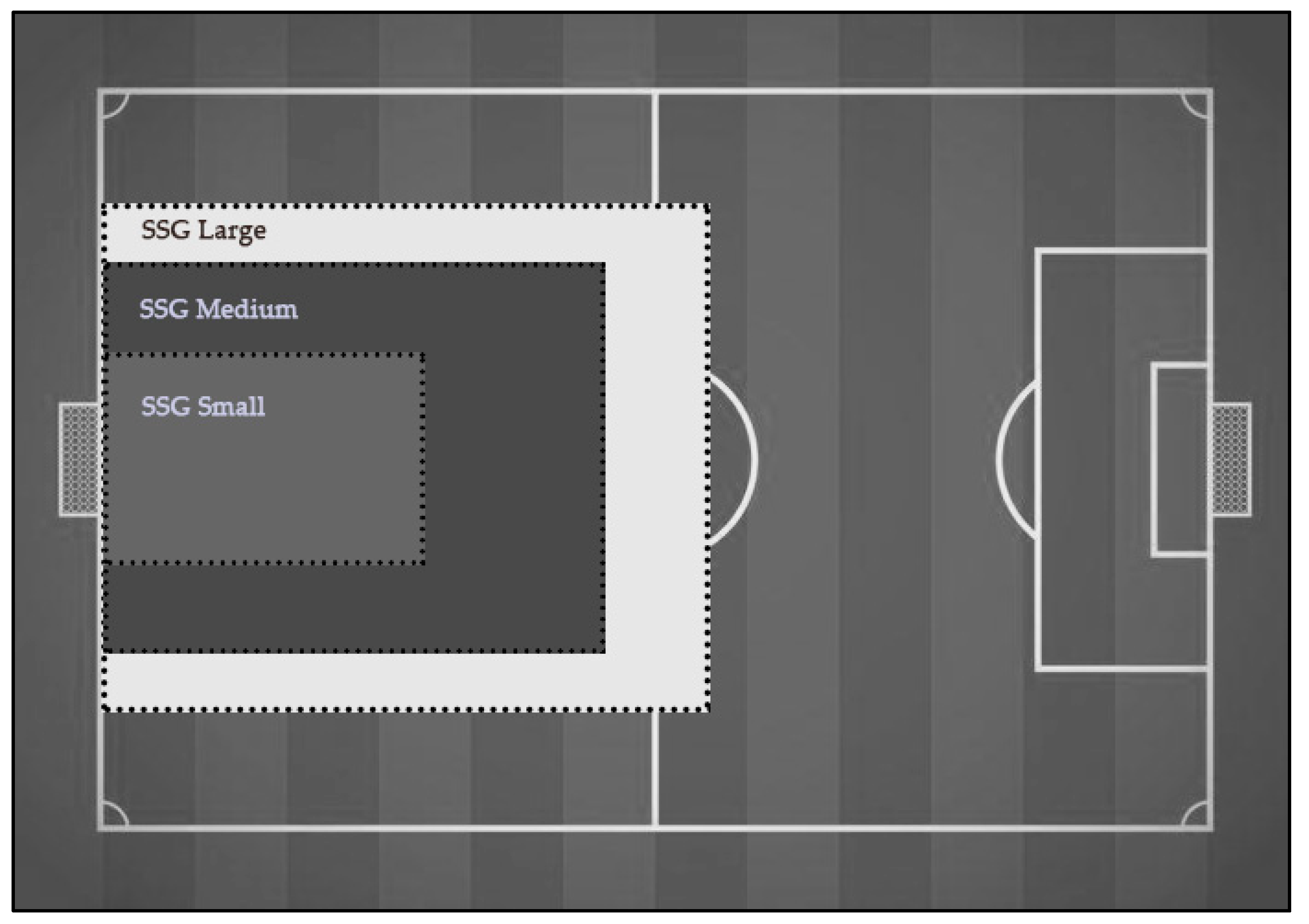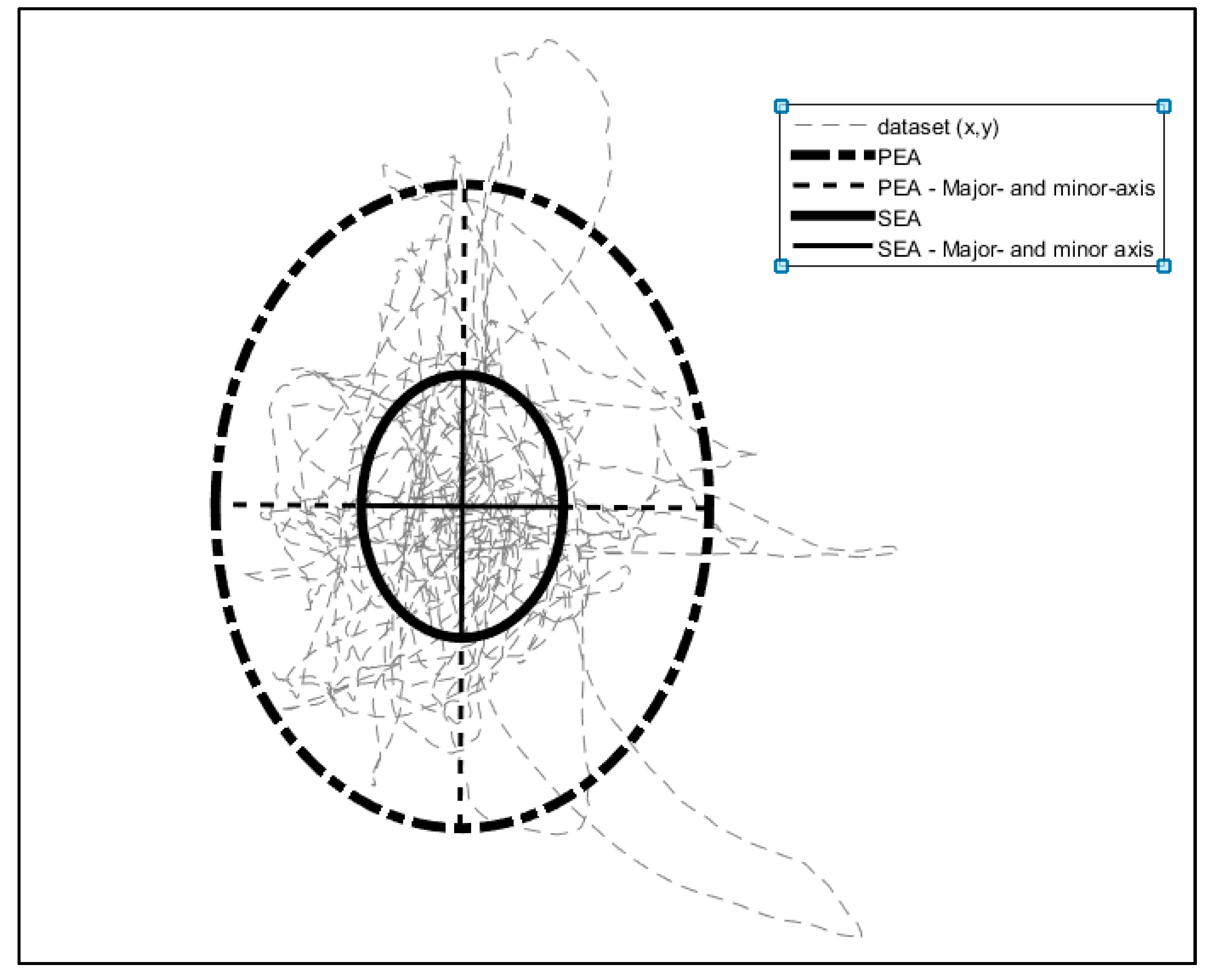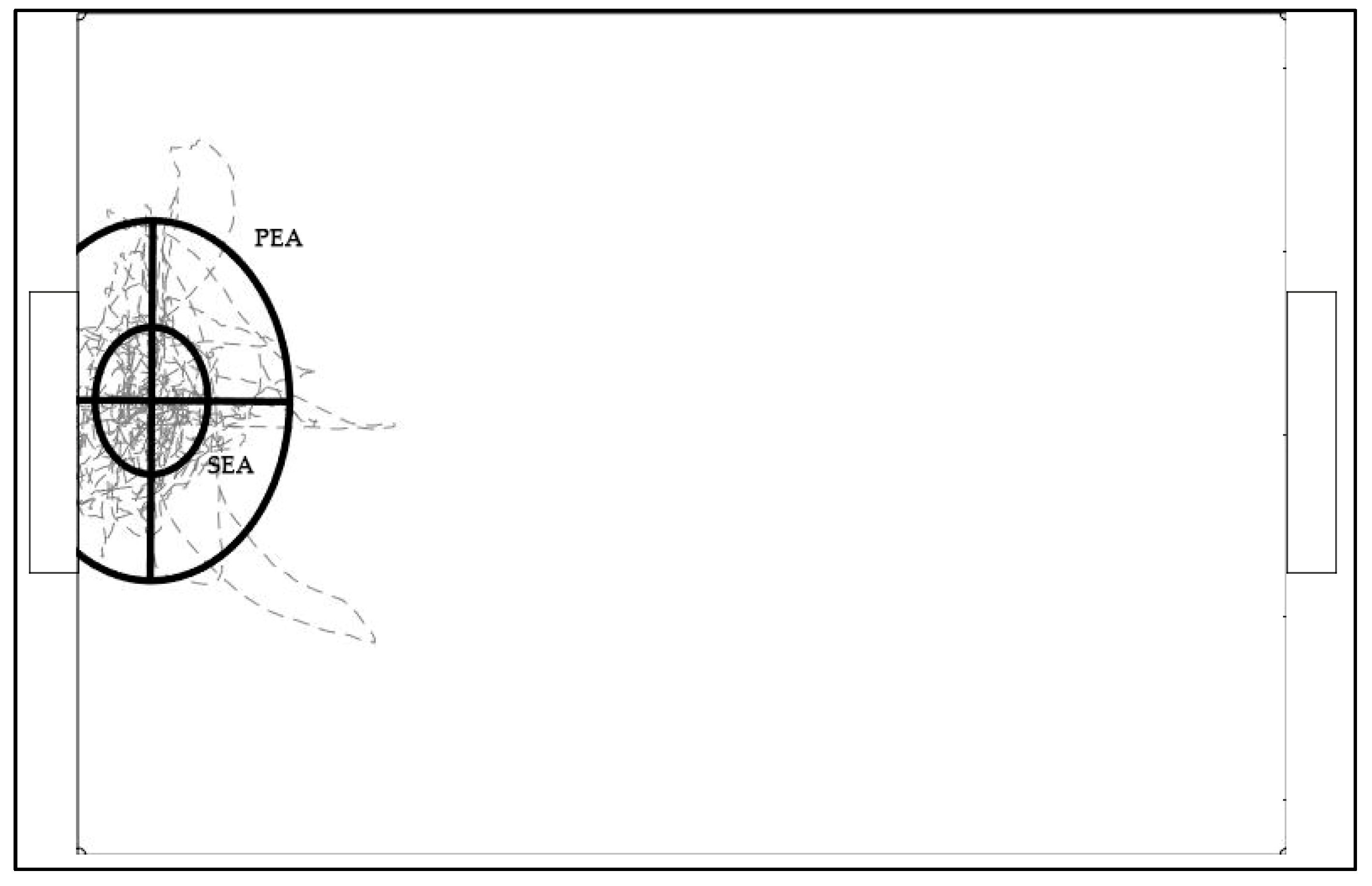Physical and Tactical Demands of the Goalkeeper in Football in Different Small-Sided Games
Abstract
1. State of Art
2. Research and Development
3. Materials and Methods
3.1. Participants
3.2. Experimental Task
3.3. Procedures
3.3.1. Pitch-Positioning Derived-Variables
3.3.2. Spatial Exploration Index (SEI)
3.3.3. Ellipses
3.3.4. Standard Ellipse Area (SEA)
3.3.5. Prediction Ellipse Area (PEA)
3.4. Statistical Analysis
4. Results
5. Discussion
6. Conclusions and Practical Applications
Author Contributions
Funding
Acknowledgments
Conflicts of Interest
References
- Aughey, R.J. Applications of GPS Technologies to Field Sports. Int. J. Sports Physiol. Perform. 2011, 6, 295–310. [Google Scholar] [CrossRef] [PubMed]
- Casamichana, D.; Castellano, J.; Calleja-Gonzalez, J.; San Román, J.; Castagna, C. Relationship Between Indicators of Training Load in Soccer Players. J. Strength Cond. Res. 2012, 27, 369–374. [Google Scholar] [CrossRef] [PubMed]
- Coutts, A.J.; Duffield, R. Validity and reliability of GPS devices for measuring movement demands of team sports. J. Sci. Med. Sport 2010, 13, 133–135. [Google Scholar] [CrossRef] [PubMed]
- Cummins, C.; Orr, R.; O’Connor, H.; West, C. Global Positioning Systems (GPS) and Microtechnology Sensors in Team Sports: A Systematic Review. Sport Med. 2013, 43, 1025–1042. [Google Scholar] [CrossRef] [PubMed]
- Sullivan, C.; Bilsborough, J.C.; Cianciosi, M.; Hocking, J.; Cordy, J.; Coutts, A.J. Match score affects activity profile and skill performance in professional Australian Football players. J. Sci. Med. Sport 2014, 17, 326–331. [Google Scholar] [CrossRef] [PubMed]
- Owen, A.L.; Wong, D.P.; Paul, D.; Dellal, A. Physical and technical comparisons between various-sided games within professional soccer. Int. J. Sports Med. 2014, 35, 286–292. [Google Scholar] [CrossRef] [PubMed]
- Gonçalves, B.; Esteves, P.; Folgado, H.; Ric, Á.; Torrents, C.; Sampaio, J. Effects of Pitch Area-Restrictions on Tactical Behavior, Physical, and Physiological Performances in Soccer Large-Sided Games. J. Strength Cond. Res. 2017, 31, 2398–2408. [Google Scholar] [CrossRef] [PubMed]
- Silva, P.; Vilar, L.; Davids, K.; Araújo, D.; Garganta, J. Sports teams as complex adaptive systems: Manipulating player numbers shapes behaviours during football small-sided games. Springerplus 2016, 5, 191. [Google Scholar] [CrossRef]
- Barron, D.J.; Atkins, S.; Edmundson, C.; Fewtrell, D. Accelerometer derived load according to playing position in competitive youth soccer. Int. J. Perform. Anal. Sport 2014, 14, 734–743. [Google Scholar] [CrossRef]
- Malone, J.; Jaspers, A.; Helsen, W.; Merks, B.; Frencken, W.G.P.; Brink, M.S. Seasonal Training Load and Wellness Monitoring in a Professional Soccer Goalkeeper. Int. J. Sports Physiol. Perform. 2018, 13, 672–675. [Google Scholar] [CrossRef]
- Sarmento, H.; Marcelino, R.; Anguera, M.T.; CampaniÇo, J.; Matos, N.; LeitÃo, J.C. Match analysis in football: A systematic review. J. Sports Sci. 2014, 32, 1831–1843. [Google Scholar] [CrossRef] [PubMed]
- Rossi, A.; Pappalardo, L.; Cintia, P.; Iaia, F.M.; Fernàndez, J.; Medina, D. Effective injury forecasting in soccer with GPS training data and machine learning. PLoS ONE 2018, 13, 1–15. [Google Scholar] [CrossRef] [PubMed]
- Aroganam, G.; Manivannan, N.; Harrison, D. Review on Wearable Technology Sensors Used in Consumer Sport Applications. Sensors 2019, 19, 1983. [Google Scholar] [CrossRef] [PubMed]
- Malone, J.; Di Michele, R.; Morgans, R.; Burgess, D.; Morton, J.; Drust, B. Seasonal Training-Load Quantification in Elite English Premier League Soccer Players. Int. J. Sports Physiol. Perform. 2015, 10, 489–497. [Google Scholar] [CrossRef]
- Robles-Palazón, F.J.; Cejudo, A.; Ayala, F.; Sainz de Baranda, P. Características de las estrategias de prevención de lesiones en niños y adolescentes deportistas. J. Sport Heal. Res. 2019, 11, 1–16. [Google Scholar]
- Olmedilla, A.; García-Alarcón, M.; Ortega, E. Relaciones entre lesiones deportivas y estrés en fútbol 11 y fútbol sala femenino. J. Sport Heal. Res. 2018, 10, 339–348. [Google Scholar]
- Fradua, L.; Zubillaga, A.; Caro, Ó.; Fernández-García, Á.I.; Ruiz-Ruiz, C.; Tenga, A. Designing small-sided games for training tactical aspects in soccer: Extrapolating pitch sizes from full-size professional matches. J. Sports Sci. 2013, 31, 573–581. [Google Scholar] [CrossRef]
- Sarmento, H.; Clemente, F.M.; Harper, L.D.; da Costa, I.T.; Owen, A.; Figueiredo, A.J. Small sided games in soccer—A systematic review. Int. J. Perform. Anal. Sport 2018, 18, 693–749. [Google Scholar] [CrossRef]
- Casamichana, D.; Castellano, J.; Castagna, C. Comparing the Physical Demands of Friendly Matches and Small-Sided Games in Semiprofessional Soccer Players. J. Strength Cond. Res. 2012, 26, 837–843. [Google Scholar] [CrossRef]
- Dellal, A.; Chamari, K.; Owen, A.L.; Wong, D.P.; Lago-Penas, C.; Hill-Haas, S. Influence of technical instructions on the physiological and physical demands of small-sided soccer games. Eur. J. Sport Sci. 2011, 11, 341–346. [Google Scholar] [CrossRef]
- Aasgaard, M.; Kilding, A. Does Man Marking Influence Running Outputs and Intensity During Small-Sided Soccer Games? J. Strength Cond. Res. 2018. [Google Scholar] [CrossRef]
- Brandes, M.; Elvers, S. Elite Youth Soccer Players’ Physiological Responses, Time-Motion Characteristics, and Game Performance in 4 vs. 4 Small-Sided Games: The Influence of Coach Feedback. J. Strength Cond. Res. 2017, 31, 2652–2658. [Google Scholar] [CrossRef]
- Fanchini, M.; Azzalin, A.; Castagna, C.; Schena, F.; Mccall, A.; Impellizzeri, F. Effect of Bout Duration on Exercise Intensity and Technical Performance of Small-Sided Games in Soccer. J. Strength Cond. Res. 2011, 25, 453–458. [Google Scholar] [CrossRef]
- Owen, A.; Wong, D.P.; McKenna, M.; Dellal, A. Heart Rate Responses and Technical Comparison Between Small- vs. Large-Sided Games in Elite Professional Soccer. J. Strength Cond. Res. 2011, 25, 2104–2110. [Google Scholar] [CrossRef]
- Frencken, W.; Lemmink, K.; Delleman, N.; Visscher, C. Oscillations of centroid position and surface area of soccer teams in small-sided games. Eur. J. Sport Sci. 2011, 11, 215–223. [Google Scholar] [CrossRef]
- Barnabé, L.; Volossovitch, A.; Duarte, R.; Ferreira, A.P.; Davids, K. Age-related effects of practice experience on collective behaviours of football players in small-sided games. Hum. Mov. Sci. 2016, 48, 74–81. [Google Scholar] [CrossRef]
- Olthof, S.B.H.; Frencken, W.G.P.; Lemmink, K.A.P.M. The older, the wider: On-field tactical behavior of elite-standard youth soccer players in small-sided games. Hum. Mov. Sci. 2015, 41, 92–102. [Google Scholar] [CrossRef]
- Bujalance-Moreno, P.; Pinillos, F.; Latorre Román, P. Effects of a small-sided game-based training programme on repeated sprint and change of direction abilities in recreationally-trained football players. J. Sports Med. Phys. Fitness 2017, 58, 1021–1028. [Google Scholar]
- Ometto, L.; Vasconcellos, F.V.A.; Cunha, F.A.; Teoldo, I.; Souza, C.R.B.; Dutra, M.B.; O’Sullivan, M.; Davids, K. How manipulating task constraints in small-sided and conditioned games shapes emergence of individual and collective tactical behaviours in football: A systematic review. Int. J. Sports Sci. Coach. 2018, 13, 1200–1214. [Google Scholar] [CrossRef]
- Sgrò, F.; Bracco, S.; Pignato, S.; Lipoma, M. Small-Sided Games and Technical Skills in Soccer Training: Systematic Review and Implications for Sport and Physical Education Practitioners. J Sports Sci 2018, 6, 9–19. [Google Scholar]
- Hill-Haas, S.V.; Dawson, B.; Impellizzeri, F.M.; Coutts, A.J. Physiology of small-sided games training in football: A systematic review. Sports Med. 2011, 41, 199–220. [Google Scholar] [CrossRef]
- Casamichana, D.; Bradley, P.S.; Castellano, J. Influence of the Varied Pitch Shape on Soccer Players Physiological Responses and Time-Motion Characteristics During Small-Sided Games. J. Hum. Kinet. 2018, 64, 171–180. [Google Scholar] [CrossRef]
- Casamichana, D.; Castellano, J. Time-motion, heart rate, perceptual and motor behaviour demands in small-sides soccer games: Effects of pitch size. J. Sports Sci. 2010, 28, 1615–1623. [Google Scholar] [CrossRef]
- Castagna, C.; D’Ottavio, S.; Cappelli, S.; Póvoas, S.C.A. The Effects of Long Sprint Ability Oriented Small-Sided Games Using Different Players-to-Pitch Area on Internal and External Load in Soccer Players. Int. J. Sports Physiol. Perform. 2019, 1–23. [Google Scholar] [CrossRef]
- Halouani, J.; Chtourou, H.; Gabbett, T.; Chaouachi, A.; Chamari, K. Small-sided games in team sports training: a brief review. J. Strength Cond. Res. 2014, 28, 3594–3618. [Google Scholar] [CrossRef]
- Jara, D.; Ortega, E.; Gómez, M.-Á.; de Baranda, P.S. Effect of Pitch Size on Technical-Tactical Actions of the Goalkeeper in Small-Sided Games. J. Hum. Kinet. 2018, 62, 157–166. [Google Scholar] [CrossRef]
- Sainz de Baranda, P.; Llopis, L.; Ortega, E. Metodología Global Para el Entrenamiento del Portero de Fútbol; Wanceulen: Sevilla, Spain, 2005. [Google Scholar]
- Gutiérrez, J.; Casamichana, D.; Castellano, J.; Sánchez-Sánchez, J. Influencia de la localización geográfica de los partidos de fútbol en la respuesta física de equipos que compiten en la Segunda División Española. J. Sport Heal. Res. 2018, 10, 295–302. [Google Scholar]
- Hoppe, M.W.; Baumgart, C.; Polglaze, T.; Freiwald, J. Validity and reliability of GPS and LPS for measuring distances covered and sprint mechanical properties in team sports. PLoS ONE 2018, 13, 1–21. [Google Scholar] [CrossRef]
- Espada, J.P.; García-Díaz, V.; Crespo, R.G.; Pelayo G-Bustelo, B.C.; Cueva Lovelle, J.M. Improving the GPS Location Quality Using a Multi-agent Architecture Based on Social Collaboration. In Proceedings of the Practical Applications of Intelligent Systems; Wen, Z., Li, T., Eds.; Springer: Berlin/Heidelberg, Germany, 2014; pp. 371–379. [Google Scholar]
- Folgado, H.; Duarte, R.; Fernandes, O.; Sampaio, J. Competing with Lower Level Opponents Decreases Intra-Team Movement Synchronization and Time-Motion Demands during Pre-Season Soccer Matches. PLoS ONE 2014, 9, 1–9. [Google Scholar] [CrossRef]
- Schubert, P.; Kirchner, M. Ellipse area calculations and their applicability in posturography. Gait Posture 2014, 39, 518–522. [Google Scholar] [CrossRef]
- Gong, J. Clarifying the Standard Deviational Ellipse. Geogr. Anal. 2002, 34, 155–167. [Google Scholar] [CrossRef]
- Levine, N. CrimeStat: A Spatial Statistical Program for the Analysis of Crime Incidents. In Encyclopedia of GIS; Shekhar, S., Xiong, H., Zhou, X., Eds.; Springer International Publishing: Cham, Switzerland, 2017; pp. 381–388. ISBN 978-3-319-17885-1. [Google Scholar]
- Batshcelet, E. Circular Statistics in Biology; Academic Press: London, UK; New York, NY, USA, 1981. [Google Scholar]
- Lefever, D.W. Measuring Geographic Concentration by Means of the Standard Deviational Ellipse. Am. J. Sociol. 1926, 32, 88–94. [Google Scholar] [CrossRef]
- Yuill, R.S. The Standard Deviational Ellipse; An Updated Tool for Spatial Description. Geogr. Ann. Ser. B Hum. Geogr. 1971, 53, 28–39. [Google Scholar] [CrossRef]
- Hopkins, W.G. Linear Models and Effect Magnitudes for Research, Clinical and Practical Applications. Sportscience 2010, 14, 49–57. [Google Scholar]
- Hopkins, W.G. Progressive statistics for studies in sports medicine and exercise science. Med. Sci. Sport Exerc. 2009, 41, 3–13. [Google Scholar] [CrossRef]
- White, A.; Hills, S.P.; Cooke, C.B.; Batten, T.; Kilduff, L.P.; Cook, C.J.; Roberts, C.; Russell, M. Match-Play and Performance Test Responses of Soccer Goalkeepers: A Review of Current Literature. Sport Med. 2018, 48, 2497–2516. [Google Scholar] [CrossRef]
- Sainz De Baranda, P.; Ortega, E.; Palao, J.M. Analysis of goalkeepers’ defence in the World Cup in Korea and Japan in 2002. Eur. J. Sport Sci. 2008, 8, 127–134. [Google Scholar] [CrossRef]
- Di Salvo, V.; Benito, P.J.; Calderón, F.J.; Di Salvo, M.; Pigozzi, F. Activity profile of elite goalkeepers during football match-play. J. Sports Med. Phys. Fitness 2008, 48, 443–446. [Google Scholar]
- Clemente, F.; Couceiro, M.; Martins, F.; Ognyanova Ivanova, M.; Mendes, R. Activity Profiles of Soccer Players During the 2010 World Cup. J. Hum. Kinet. 2013, 38, 201–211. [Google Scholar] [CrossRef][Green Version]
- Parus, P.; Chmura, P.; Konefał, M.; Andrzejewski, M.; Kowalczuk, E.; Chmura, J. Distance Covered Below and Above the Anaerobic Threshold by Elite German Goalkeepers. Cent. Eur. J. Sport Sci. Med. 2017, 17, 25–32. [Google Scholar] [CrossRef][Green Version]
- Clemente, F.M.; Owen, A.; Serra-Olivares, J.; Correia, A.; Sequeiros, J.B.; Silva, F.G.M.; Martins, F.M.L. The effects of large-sided soccer training games and pitch size manipulation on time–motion profile, spatial exploration and surface area: Tactical opportunities. Proc. Inst. Mech. Eng. Part P J. Sport Eng. Technol. 2018, 232, 160–165. [Google Scholar] [CrossRef]
- Couceiro, M.; Clemente, F.; Martins, F.; Tenreiro Machado, J. Dynamical Stability and Predictability of Football Players: The Study of One Match. Entropy 2014, 16, 645–674. [Google Scholar] [CrossRef]
- Köklü, Y.; Alemdaroğlu, U.; Özkan, A.; Koz, M.; Ersöz, G. The relationship between sprint ability, agility and vertical jump performance in young soccer players. Sci. Sports 2015, 30, e1–e5. [Google Scholar] [CrossRef]



| Variables | SSG Scenarios | ||
|---|---|---|---|
| Small | Medium | Large | |
| Absolut Distance Covered (m) | 445.1 ± 44.3 (398.6 to 491.6) a,b | 319 ± 25.3 (292.5 to 345.6) c | 255.2 ± 25.9 (228.1 to 282.4) |
| SEI | 2.2 ± 0.3 (1.9 to 2.5) a,b | 3.2 ± 0.4 (2.8 to 3.6) | 3 ± 0.4 (2.5 to 3.4) |
| PEA (m2) | 67.6 ± 18.8 (47.9 to 87.4) a,b | 128 ± 31.6 (94.8 to 161.2) | 129.1 ± 46.5 (80.2 to 177.9) |
| SEA (m2) | 11.3 ± 3.1 (8.0 to 14.6) a,b | 21.4 ± 5.3 (15.8 to 26.9) | 21.4 ± 7.8 (13.2 to 29.6) |
| DISTANCE COVERED Walking (<3.5 km/h) | 159 ± 12.6 (145.8 to 172.2) a | 162.1 ± 25.8 (135.0 to 189.1) c | 126.6 ± 19.6 (106.1 to 147.2) |
| Jogging (3.6–14.3 km/h) | 278.6 ± 48.6 (227.6 to 329.5) a,b | 148.9 ± 42.4 (104.4 to 193.4) | 120.9 ± 20.3 (99.6 to 142.2) |
| Running (14.4–19.8 km/h) | 7.6 ± 5.3 (2 to 13.2) | 5.1 ± 4.6 (0.3 to 9.9) | 5.9 ± 4.4 (1.3 to 10.5) |
| Sprint (>19.9 km/h) | 1.6 ± 2.1 (−0.6 to 3.8) | ||
| Number of Accelerations (>3 m/s2) | 5.5 ± 3.9 (1.4 to 9.6) | 2.7 ± 1.9 (0.7 to 4.6) | 4 ± 0.6 (3.3 to 4.7) |
| Number of Deccelerations (<−3 m/s2) | 4.2 ± 2.9 (1.1 to 7.2) | 2.5 ± 1.6 (0.8 to 4.2) | 4 ± 1.1 (2.9 to 5.1) |
| Variables | (a) Small v Medium | (b) Small v Large | (c) Medium v Large |
|---|---|---|---|
| Absolute Distance Covered (m) | −2.23 ± 1.2 | −4.31 ± 1.59 | −2.08 ± 0.63 |
| very likely ↓ | most likely ↓ | most likely ↓ | |
| SEI | 3.66 ± 0.99 | 3.08 ± 0.81 | −0.58 ± 1.47 |
| most likely ↑ | most likely ↑ | unclear | |
| PEA (m2) | 3.15 ± 0.96 | 3.05 ± 1.27 | −0.1 ± 1.54 |
| most likely ↑ | most likely ↑ | unclear | |
| SEA (m2) | 3.15 ± 0.96 | 3.01 ± 1.28 | −0.14 ± 1.57 |
| most likely ↑ | most likely ↑ | unclear | |
| Distance Covered Walking (<3.5 km/h) | −0.57 ± 1.86 | −2.93 ± 2.09 | −2.36 ± 1.58 |
| unclear | very likely ↓ | very likely ↓ | |
| Jogging (3.6–14.3 km/h) | −2.20 ± 1.84 | −3.62 ± 1.46 | −1.42 ± 0.54 |
| very likely ↓ | most likely ↓ | most likely ↓ | |
| Running (14.4–19.8 km/h) | 1.17 ± 2.2 | 0.27 ± 0.67 | −0.64 ± 1.47 |
| unclear | unclear | unclear | |
| Sprint (>19.9 km/h) | unclear | unclear | unclear |
| Number of Accelerations (>3 m/s2) | −2.9 ± 4.85 | −0.33 ± 4.59 | 2.57 ± 6.95 |
| unclear | unclear | unclear | |
| Number of Decelerations (≤3 m/s2) | −1.91 ± 2.85 | −1.36 ± 2.88 | 0.55 ± 3.87 |
| unclear | unclear | unclear |
© 2019 by the authors. Licensee MDPI, Basel, Switzerland. This article is an open access article distributed under the terms and conditions of the Creative Commons Attribution (CC BY) license (http://creativecommons.org/licenses/by/4.0/).
Share and Cite
Jara, D.; Ortega, E.; Gómez-Ruano, M.-Á.; Weigelt, M.; Nikolic, B.; Sainz de Baranda, P. Physical and Tactical Demands of the Goalkeeper in Football in Different Small-Sided Games. Sensors 2019, 19, 3605. https://doi.org/10.3390/s19163605
Jara D, Ortega E, Gómez-Ruano M-Á, Weigelt M, Nikolic B, Sainz de Baranda P. Physical and Tactical Demands of the Goalkeeper in Football in Different Small-Sided Games. Sensors. 2019; 19(16):3605. https://doi.org/10.3390/s19163605
Chicago/Turabian StyleJara, Daniel, Enrique Ortega, Miguel-Ángel Gómez-Ruano, Matthias Weigelt, Brittany Nikolic, and Pilar Sainz de Baranda. 2019. "Physical and Tactical Demands of the Goalkeeper in Football in Different Small-Sided Games" Sensors 19, no. 16: 3605. https://doi.org/10.3390/s19163605
APA StyleJara, D., Ortega, E., Gómez-Ruano, M.-Á., Weigelt, M., Nikolic, B., & Sainz de Baranda, P. (2019). Physical and Tactical Demands of the Goalkeeper in Football in Different Small-Sided Games. Sensors, 19(16), 3605. https://doi.org/10.3390/s19163605






